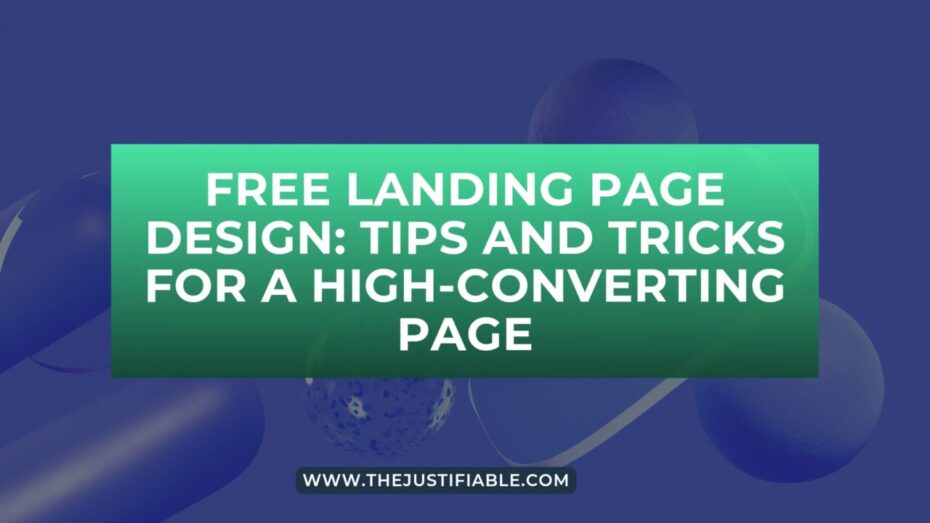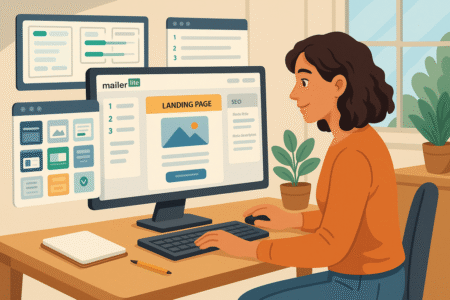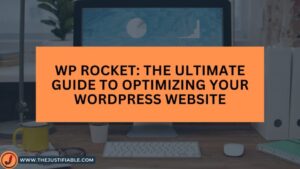Table of Contents
Free Landing Page Design! In today’s competitive digital landscape, creating an effective landing page is crucial to capturing leads and driving conversions. However, with tight budgets and limited resources, many businesses and entrepreneurs are turning to free landing pages to achieve their marketing goals.
This comprehensive guide will provide you with tips and tricks for designing high-converting free landing pages, from choosing the right templates and builders to optimizing your pages for all devices.
We will also explore tools and resources to enhance your landing page performance, strategies for effective lead generation, and how to analyze and improve your landing page’s performance. By harnessing the power of free marketing landing pages, you can boost your online presence and drive success for your business.
Maximizing the Potential of Free Landing Pages
When it comes to promoting your business or product, free landing pages can play a crucial role in capturing leads and driving conversions. To maximize the potential of these pages, it’s essential to understand how to design a high-converting landing page using the best free landing pages tools and resources available.
In this section, we will explore tips and tricks to help you make the most of free landing page templates, builders, and design elements, ensuring your page stands out and achieves its goals.
- Choose the right free landing page builder: There are several free landing page builders available, such as Mailchimp, Wix, and WordPress. Consider your requirements, technical skills, and desired features when selecting the best free landing page software for your needs.
- Utilize free landing page templates: Free landing page templates can save you time and provide inspiration for your design. Look for free responsive landing pages or free mobile-friendly landing pages to ensure your content displays optimally across devices. Customize the templates to align with your brand identity and message.
- Keep it simple and focused: A clutter-free design can help your visitors focus on your call-to-action (CTA). Limit the amount of information and visuals on your page, ensuring a clear and concise message. Utilize free one-page landing templates for a streamlined design.
- Incorporate compelling headlines: Your headline should be attention-grabbing and provide a clear value proposition. Use free landing page examples for inspiration and test different headlines to see which one resonates most with your audience.
- Optimize your CTA: Use persuasive, action-oriented language for your CTA buttons. Place them strategically throughout the page and make sure they are easily visible. Test different colors, fonts, and button sizes to find the most effective combination.
Choosing the Right Free Landing Page Templates
Selecting the perfect free landing page template can be a game-changer in your marketing efforts. With numerous options available, it’s essential to choose a template that aligns with your goals and caters to your target audience’s needs.
In this section, we will discuss crucial factors to consider when selecting the right free landing page templates to ensure the best results. Identify your objectives: Determine the primary goal of your landing page, whether it’s lead generation, sales, or brand awareness.
This clarity will help you select a template that caters specifically to your objectives. Assess template responsiveness: In today’s multi-device world, it’s crucial to choose free responsive landing pages or mobile-friendly templates that render well on all devices. This ensures a seamless user experience and helps improve conversion rates.
- Consider design aesthetics: Look for templates that align with your brand’s visual identity and design language. Consistent branding helps establish credibility and trust with your audience.
- Evaluate customization options: Choose templates that offer customization features, allowing you to tailor the design, layout, and content to fit your unique requirements. Flexibility in customization can help you create a more personalized and effective landing page.
- Review built-in features: Some free landing page templates come with pre-built features like forms, CTAs, and social sharing buttons. Opt for templates with relevant functionalities that suit your marketing goals and streamline the user experience.
- Study template performance: Research how well a particular template has performed for others in terms of conversion rates and user engagement. This can provide valuable insights into its effectiveness and help you make a more informed decision.
- Check compatibility with your platform: Ensure that the template you select is compatible with your content management system (CMS) or landing page builder, whether it’s WordPress, Wix, or another platform.
- Analyze industry-specific templates: Some templates cater specifically to certain industries, like e-commerce, affiliate marketing, or lead generation. Using industry-specific templates can help you create a more targeted and relevant landing page.
Assessing Your Business Needs and Goals
Before diving into the world of free landing pages, it’s crucial to have a clear understanding of your business needs and goals. A well-defined strategy not only helps you make the most of available resources but also ensures that your landing page aligns with your overall marketing objectives.
In this section, we’ll discuss the importance of assessing your business needs and goals and how to use that information to create a high-converting landing page.
- Identify your target audience: Understanding who your target audience is and what they’re looking for is essential. Take the time to research and define your ideal customer – their demographics, preferences, and pain points. This knowledge will help you create a landing page that speaks directly to their needs.
- Establish your primary goal: What do you want your visitors to do when they arrive at your landing page? Your goal might be to collect email addresses, sell a product, or increase brand awareness. Having a clear objective will guide your landing page design and content choices.
- Align your landing page with your marketing strategy: Ensure that your landing page complements your broader marketing strategy. Your messaging, visuals, and offers should be consistent across all marketing channels, creating a seamless experience for your audience.
- Analyze competitors: Research what your competitors are doing with their landing pages – what works well for them and what doesn’t. Use these insights to inform your strategy and set your landing page apart.
- Determine your unique selling proposition (USP): Your USP is what makes your product or service stand out from the competition. Clearly communicate your USP on your landing page to capture your audience’s attention and persuade them to take action.
- Set key performance indicators (KPIs): Identify the metrics you’ll use to measure the success of your landing page, such as conversion rates, bounce rates, and click-through rates. Establishing KPIs will help you track your progress and optimize your landing page over time.
Comparing Free Landing Page Builders
With numerous free landing page builders available, finding the right one for your business can seem overwhelming. By comparing features, ease of use, and flexibility, you can select a tool that best suits your needs and helps you create high-converting landing pages.
In this section, we’ll discuss the key aspects to consider when comparing free landing page builders and highlight some popular options to get you started.
- Ease of use: For those with limited technical skills, choosing a user-friendly landing page builder is crucial. Look for tools with drag-and-drop functionality and intuitive interfaces that make designing your landing page a breeze.
- Customization options: Your landing page builder should offer a range of customization options to help you create a unique and personalized page. This includes the ability to modify templates, colors, fonts, and other design elements.
- Responsive design: Ensure that your chosen landing page builder supports responsive design, allowing your page to display optimally across various devices, including desktop, tablet, and mobile.
- Integration capabilities: A good landing page builder should integrate seamlessly with your existing marketing tools, such as email marketing platforms, analytics tools, and CRM systems. This enables you to efficiently manage leads and track the performance of your landing page.
- Template library: A diverse selection of pre-built templates can provide a solid foundation for your landing page design. Choose a builder that offers templates catering to your industry and marketing goals.
- Support and resources: Opt for a landing page builder with strong customer support and educational resources, like tutorials and webinars. These resources can help you make the most of the tool and troubleshoot any issues that may arise.
Some popular free landing page builders to consider include:
- Mailchimp: Known primarily for email marketing, Mailchimp also offers a free landing page builder with a selection of customizable templates, integrations, and analytics capabilities.
- Wix: This website builder includes a free landing page creator with an easy-to-use interface, a variety of templates, and powerful design features.
- WordPress: With numerous free landing page themes and plugins, WordPress can be an excellent choice for those already using the platform for their website.
Key Elements of High-Converting Free Landing Page Design
A well-designed landing page can significantly boost conversions and help you achieve your marketing goals. By focusing on key design elements, you can create an engaging and user-friendly experience that encourages your audience to take action.
In this section, we’ll discuss the crucial components of high-converting free landing page design to guide you in creating an effective and visually appealing page.
- Clear and compelling headline: Your headline should instantly grab your visitor’s attention and convey the primary benefit of your product or service. Keep it concise, informative, and relevant to your target audience.
- Engaging visuals: High-quality images or videos can help communicate your value proposition and make your landing page more visually appealing. Choose visuals that complement your messaging and resonate with your audience.
- Well-structured content: Organize your content using headings, bullet points, and short paragraphs to make it easy for visitors to scan and understand. Focus on addressing your audience’s pain points and explaining how your product or service offers a solution.
- Strong call-to-action (CTA): Your CTA should be clear, persuasive, and prominently placed on your landing page. Use action-oriented language and contrasting colors to make your CTA stand out.
- Social proof: Testimonials, customer reviews, and case studies can build trust and credibility with your audience. Incorporate these elements strategically throughout your landing page to reassure visitors of the value you provide.
- Trust signals: Displaying logos of well-known clients, partners, or industry certifications can increase trust and encourage visitors to engage with your content.
- Minimalist design: Keep your design clean and clutter-free to help visitors focus on your message and CTA. Use white space effectively and avoid overwhelming your audience with too much information.
- Mobile-friendly design: With the majority of users accessing the internet via mobile devices, it’s essential to ensure your landing page is mobile-friendly. Opt for responsive design or mobile-first templates to provide a seamless user experience across devices.
- Fast-loading pages: Slow-loading landing pages can lead to high bounce rates and lost conversions. Optimize your images, compress your code, and consider using a content delivery network (CDN) to improve page load times.
Compelling Headlines and Copy
Captivating headlines and persuasive copy are essential components of a high-converting landing page. They work together to engage your audience, convey your value proposition, and motivate visitors to take action. In this section, we’ll discuss the importance of crafting compelling headlines and copy and share tips to make your content stand out.
- Attention-grabbing headlines: Your headline is often the first thing visitors see, so it should immediately capture their attention. Make it clear, concise, and focused on the main benefit of your product or service. Use strong language and consider incorporating numbers or questions to pique curiosity.
- Subheadings that support your message: Subheadings help break up your content and guide your visitors through the page. Use them to emphasize key points and maintain your audience’s interest.
- Addressing pain points: Your copy should address the challenges your target audience faces and demonstrate how your product or service offers a solution. Use empathetic language to show that you understand their concerns and needs.
- Persuasive language: To inspire action, use persuasive language and active verbs in your copy. Highlight the benefits and advantages of your product or service, and create a sense of urgency with phrases like “limited time offer” or “exclusive deal.”
- Keep it concise: Avoid overwhelming your audience with too much information. Keep your copy concise and focused on the most important points. Use bullet points or numbered lists to present information in an easily digestible format.
- Storytelling: Incorporating storytelling elements into your copy can make it more engaging and memorable. Share a relatable customer story or use vivid descriptions to paint a picture of the experience your product or service provides.
- Test and optimize: Continuously test different headlines and copy variations to determine which resonate best with your audience. Use analytics tools to track conversion rates and other key metrics.
Strong Calls-to-Action (CTAs)
A powerful call-to-action (CTA) is a critical component of any high-converting landing page. Your CTA prompts visitors to take a specific action, whether it’s signing up for a newsletter, downloading an eBook, or making a purchase. In this section, we’ll discuss the importance of crafting strong CTAs and share tips on how to make your CTAs more effective and compelling.
- Clear and concise language: Your CTA should be straightforward and easy to understand. Use action-oriented language, such as “Download Now,” “Sign Up,” or “Get Started,” to inspire your visitors to take immediate action.
- Visibility and contrast: Make sure your CTA button stands out on the page by using contrasting colors and a prominent placement. Consider placing your CTA above the fold (visible without scrolling) and at strategic points throughout your landing page.
- Urgency and exclusivity: Create a sense of urgency or exclusivity with phrases like “Limited Time Offer,” “Exclusive Deal,” or “Act Now” to encourage visitors to take action before the opportunity is gone.
- Use of whitespace: Surround your CTA with ample whitespace to make it more prominent and visually appealing. This helps draw the visitor’s attention to the CTA and reduces distractions.
- CTA button size and shape: Test different button sizes, shapes, and fonts to find the most effective combination. Your CTA button should be large enough to be easily clickable but not so large that it overwhelms other elements on the page.
- Personalization: Personalize your CTAs based on your audience’s preferences, behaviors, or demographics. For example, you might tailor your CTA for returning visitors or offer different CTAs for different segments of your audience.
- Consistency: Ensure that your CTA’s language and design are consistent with your overall branding and messaging. This creates a cohesive experience for your visitors and reinforces your brand identity.
- Test and optimize: Regularly test and optimize your CTAs to improve their performance. Experiment with different wording, colors, placements, and sizes to find the most effective combination for your audience.
Optimizing Free Responsive Landing Pages for All Devices
In today’s digital landscape, it’s crucial to optimize your landing pages for all devices, including desktop, tablet, and mobile. Ensuring that your free responsive landing pages perform well on various screen sizes and load quickly can significantly impact user experience and conversion rates.
In this section, we’ll discuss the importance of mobile-friendly landing pages, adapting to different screen sizes, optimizing load times and performance, and selecting the right WordPress themes and plugins.
Importance of Mobile-Friendly Free Landing Pages
With the majority of internet users accessing content via mobile devices, having a mobile-friendly landing page is no longer optional.
Mobile-responsive landing pages provide a seamless user experience, help improve your search engine rankings, and increase the likelihood of conversions. Let’s explore how to adapt your landing pages to different screen sizes and optimize their performance.
Adapting to Different Screen Sizes
To ensure your landing page looks great and functions well on various devices, follow these tips:
- Choose responsive templates: Opt for free landing page templates specifically designed to be responsive or mobile-first. These templates automatically adapt to different screen sizes and resolutions.
- Use fluid grids: Fluid grids allow your content to scale proportionally based on the screen size, ensuring your layout remains consistent across devices.
- Optimize images: Use responsive images that automatically adjust their size and resolution based on the user’s device. This can help reduce load times and improve the overall user experience.
- Test on multiple devices: Regularly test your landing page on various devices and screen sizes to identify and fix any display issues.
Optimizing Load Times and Performance
A fast-loading landing page can significantly impact user engagement, search rankings, and conversions. Here are some tips to optimize your landing page’s performance:
Compress images: Use image compression tools to reduce file sizes without sacrificing quality.
- Minify code: Minify your HTML, CSS, and JavaScript code to remove unnecessary characters and spaces, reducing file size and improving load times.
- Use a content delivery network (CDN): CDNs can help distribute your content across multiple servers, reducing the time it takes for users to access your landing page.
- Leverage browser caching: Browser caching can speed up load times for returning visitors by storing a cached version of your landing page.
Tips for Choosing Free Landing Page WordPress Themes and Plugins
When using WordPress for your landing pages, selecting the right themes and plugins can significantly impact your page’s responsiveness and compatibility. Here are some tips to help you make the right choice:
Assessing Responsiveness and Compatibility
- Check for mobile responsiveness: Ensure that the theme or plugin you choose is explicitly designed to be responsive or mobile-friendly.
- Test in multiple browsers: Verify that your chosen theme or plugin is compatible with all major browsers, including Chrome, Firefox, Safari, and Edge.
- Review theme or plugin documentation: Review the documentation to ensure it supports the features and functionality you need for your landing page.
Reviewing Customer Support and Updates
- Check support options: Choose themes and plugins that offer reliable customer support, such as forums, email support, or live chat.
- Read user reviews: User reviews can provide valuable insights into the quality of the theme or plugin, as well as the level of support provided.
- Verify update frequency: Regular updates are essential for maintaining compatibility, security, and performance. Choose themes and plugins with a strong track record of updates.
Enhancing Your Free Landing Page with Effective Tools and Resources
Creating a high-converting free landing page involves more than just design; it also requires leveraging various tools and resources to enhance your page’s performance and effectiveness.
In this section, we’ll discuss the benefits of using free landing page software and generators, explore HTML landing page templates, examine free hosting solutions, and share strategies for optimizing lead generation and e-commerce landing pages.
Utilizing Free Landing Page Software and Generators
Free landing page software and generators can simplify the process of creating and launching a high-converting page. These tools often come with pre-built templates, drag-and-drop functionality, and seamless integration with other marketing tools.
Exploring Free HTML Landing Page Templates
Free HTML landing page templates provide a quick and easy starting point for your landing page design. These templates often include pre-built layouts, responsive design, and customizable elements.
To get started, search for reputable sources offering free HTML templates, such as ThemeForest, Colorlib, or HTML5 UP.
Leveraging Free Landing Page Hosting Solutions
Free landing page hosting solutions can help you launch your landing page without incurring additional costs. Popular options include GitHub Pages, Netlify, and InfinityFree.
Keep in mind that free hosting may come with limitations, such as lower bandwidth, storage limits, or reduced customization options.
Implementing Strategies for Free Lead Generation Landing Pages
Effective lead generation landing pages are designed to capture visitors‘ information, such as email addresses or phone numbers. Here are some strategies to optimize your free lead generation landing pages:
Targeting Your Audience and Segmenting Traffic
Understanding your target audience is crucial for creating a landing page that resonates with them. Use audience segmentation to tailor your content, messaging, and design to specific groups based on their demographics, interests, or behaviors. This can lead to higher engagement and conversion rates.
Testing and Refining Free E-commerce Landing Pages
For e-commerce landing pages, it’s essential to continually test and refine your page to improve conversions. Some strategies include:
- A/B testing: Experiment with different headlines, images, CTAs, or other elements to determine which variations perform best.
- Personalization: Personalize your landing page based on your visitors’ preferences, browsing history, or other data to create a more relevant and engaging experience.
- Analyze user behavior: Use heatmaps, scroll maps, or other analytics tools to identify areas of your landing page that may be underperforming or causing friction.
Harnessing the Power of Free Marketing Landing Pages
Free marketing landing pages can be a powerful tool for driving conversions, generating leads, and promoting your products or services.
In this section, we’ll discuss how to effectively promote your free landing page for affiliate marketing, select the right affiliate programs and products, build trust with your audience, and drive traffic to your page through SEO strategies.
Promoting Your Free Landing Page for Affiliate Marketing
Affiliate marketing involves promoting products or services on your landing page and earning a commission for every sale or lead generated.
To succeed in affiliate marketing, it’s crucial to choose the right products, build trust with your audience, and drive targeted traffic to your landing page.
Selecting the Right Affiliate Programs and Products
To maximize the potential of your free landing page for affiliate marketing, follow these tips:
- Research your niche: Understand your target audience and identify the products or services that best align with their needs and preferences.
- Evaluate affiliate programs: Assess the commission rates, payment terms, and support provided by various affiliate programs to find the best fit for your marketing strategy.
- Look for high-quality products: Promote products or services with a strong reputation, proven track record, and positive customer reviews. This will increase the likelihood of conversions and enhance your credibility.
Building Trust and Credibility with Your Audience
Building trust and credibility with your audience is essential for successful affiliate marketing. Here are some strategies to help:
- Be transparent: Clearly disclose your affiliate relationship and let your audience know that you may earn a commission if they make a purchase through your links.
- Provide valuable content: Share informative and engaging content that addresses your audience’s needs, challenges, and interests.
- Offer honest reviews: Provide genuine, unbiased product reviews or comparisons to help your audience make informed decisions.
Driving Traffic to Your Free Landing Page with SEO
Search engine optimization (SEO) is a critical component of driving organic traffic to your free marketing landing page. Implementing effective SEO strategies will increase your page’s visibility on search engine results pages and attract more visitors.
Incorporating Relevant Keywords and Content
Optimizing your landing page for relevant keywords and content is essential for improving your search rankings. Here are some tips:
- Conduct keyword research: Use keyword research tools, such as SEOPowerSuite or SEMrush, to identify high-traffic, low-competition keywords related to your niche.
- Optimize your content: Incorporate your target keywords naturally throughout your content, including headings, subheadings, body text, and meta tags.
- Update your content regularly: Keep your content fresh and up-to-date to maintain your search rankings and engage your audience.
Focusing on User Experience and Engagement
Creating a positive user experience is vital for both SEO and conversions. Consider the following strategies to enhance your landing page’s user experience:
- Improve site speed: Optimize your images, use a content delivery network, and minify your code to reduce load times.
- Ensure mobile-friendliness: Design your landing page with mobile users in mind, using responsive design and easy-to-read fonts.
- Encourage user engagement: Use interactive elements, such as videos, quizzes, or polls, to keep your audience engaged and encourage them to spend more time on your page.
By harnessing the power of free marketing landing pages and implementing these strategies, you can drive traffic, generate leads, and increase conversions. Remember to continually monitor and optimize your landing page based on user feedback and performance metrics to ensure ongoing success.
Analyzing and Improving Free Landing Page Performance
To ensure the success of your free landing page, it’s crucial to continually analyze its performance and make improvements based on data-driven insights.
In this section, we’ll discuss how to track key metrics and conversions, set up analytics, identify areas for improvement, and conduct A/B testing to optimize your landing page elements.
Tracking Key Metrics and Conversions
Monitoring your landing page’s performance is essential for identifying trends, evaluating the effectiveness of your marketing strategies, and uncovering areas for improvement.
Setting Up Analytics for Your Free Landing Pages
To track key metrics and conversions, you’ll need to set up analytics for your landing page. Here are some steps to get started:
- Choose an analytics tool: Select a reliable analytics tool, such as Google Analytics, Adobe Analytics, or Mixpanel, to track your landing page’s performance.
- Configure your tracking code: Insert the tracking code provided by your chosen analytics tool into your landing page’s HTML code.
- Set up conversion goals: Define specific goals for your landing page, such as form submissions, downloads, or purchases, and configure your analytics tool to track these conversions.
- Monitor performance regularly: Regularly review your analytics data to identify trends, monitor the effectiveness of your marketing strategies, and uncover areas for improvement.
Identifying Areas for Improvement and Optimization
By analyzing your landing page’s performance data, you can identify areas for improvement and optimization. Some key metrics to track include:
- Bounce rate: A high bounce rate may indicate that your landing page is not engaging or relevant to your audience.
- Conversion rate: A low conversion rate may suggest that your CTAs, design, or messaging need improvement.
- Time on page: A short time on page may indicate that your content is not engaging or your page is difficult to navigate.
- Traffic sources: Understanding where your traffic is coming from can help you refine your marketing strategies and identify new opportunities for growth.
Conducting A/B Testing on Your Free Landing Page Elements
A/B testing involves comparing two versions of a landing page element, such as a headline or CTA, to determine which performs better. This data-driven approach can help you optimize your landing page for higher conversions.
Comparing Different Headlines, CTAs, and Designs
To conduct A/B testing on your landing page, follow these steps:
- Choose an element to test: Identify a specific element of your landing page, such as a headline, CTA, or design, that you’d like to optimize.
- Create a variation: Develop a new version of the chosen element, ensuring that it’s distinct from the original.
- Set up your test: Use an A/B testing tool, such as Google Optimize or Optimizely, to display the original and variation to different segments of your audience.
- Analyze the results: Review the performance data for each variation to determine which one drives higher conversions.
Iterating and Refining Based on Test Results
Once you’ve analyzed your A/B test results, take action based on your findings:
- Implement the winning variation: Update your landing page with the higher-performing variation to boost your conversion rate.
- Conduct additional tests: Continue to test and optimize other elements of your landing page to improve its overall performance.
- Learn from the results: Use the insights gained from your A/B tests to inform future marketing strategies and landing page designs.






